Smith and Wesson 38 Special Snub Nose Reviews
- Jul 03 2018
-

- 1
Gun Review: Smith & Wesson Model 642
The Truth Nigh Guns July 03, 2018 Handguns, Gun Review 1
They only carry five rounds of .38 Spl +P ammunition and, at 15 ounces, they weigh about the same as some autoloaders that agree more rounds. At first blush, it might seem that Smith & Wesson's fiddling J-frame revolvers have outlived their usefulness. If sales hateful anything, then the reply is an unqualified "yep." Smith & Wesson's J-frame revolvers remain huge sellers. But why? In that location are a lot of good reasons to own a J-frame, considering the advantages that small revolvers offer to CCW holders outweigh the disadvantages inherent in the platform. Okay, dazzler is in the eye of the beholder, and the snub-nosed holster hornet I'thousand currently beholding is the Smith & Wesson 642 Airweight. Airweight is what S&Westward calls its onetime school lightweight pocket revolvers with aluminum frames and stainless steel cylinders, cranes and barrels – and that's the entire barrel, not only a sleeve. Smith & Wesson likewise makes heavier modest revolvers all in steel and lighter "Airlight" models in exotic metals. The Airweight revolvers fall somewhere in the heart in terms of weight, and stand for a good balance between low3 and slick handling. All sold under the forgettable and confusing model numbering organization foisted upon the public past Smith & Wesson in 1957. The internal hammer DAO variant of the J-frame that'southward now called the Model 642 was originally released in time for South&Ws centennial in 1952. The internal hammer revolver is still referred to equally the "Centennial" model, which isn't a sexy name just nevertheless packs more marketing punch than "642." Smith & Wesson's J-frame revolvers remain amidst the best pocket rockets ever made; the Model 642 is perhaps the all-time of the best. The Centennial J-frame conceals well and won't hang upwardly or snag in a pocket or holster. It shoots very directly notwithstanding its tiny 1.875" barrel. I like the fact that it's not made of plastic. The all-metallic 642 sports a silver and gray terminate; the 442 is the same revolver, but with a handsome blued end. Internally, they are twins and they are the archetypes of the genre. Small snubbies are pop icons in the gun world. Bad guys and good guys, off-duty cops and on-duty thieves, detectives and detectees, striking men, striking shows and hot chicks accept all featured the Centennial as their quintessential curtained carry slice. Maestro, cue the Henry Mancini Peter Gunn Theme Music. No, because at that place are disadvantages to carrying any pocket-sized revolver. When looking at the disadvantages, we demand look no further than the 642's trigger. Sure, it has a shine surface and a sinuous curve that begs to exist pressed. Simply once pressed, the shooter will know why the lilliputian gun'due south trigger isn't knurled. Information technology would leave a permanent, pressed-in tattoo. Bluntly, the trigger of any new Airweight is as stiff as a dead carp and cries out for a power assist. Or at least a windlass. Measuring the pull weight is tough since it exceeds the limit of nigh truck scales, simply 200 kilos sounds nearly right. That's a total exaggeration of course. Would you believe more than 12 pounds? The upside of the heavy trigger is that it'due south very safe and the gun is unlikely to go off accidentally. In fact, during the first range session, a new shooter may begin to wonder if information technology will go off intentionally. Non to worry. The revolver will fire every time. A lot of dry fire will break in the revolver and soften the springs substantially, although fifty-fifty a well-used 642 trigger volition never rival that of a top-notch DA pistol. Until the trigger is well broken in, use the crease of the distal joint, called the "ability pucker" of the trigger finger. It will save a lot of unnecessary article of clothing and tear on tendons and ligaments. The 2d cure, and ane that requires no surgery except upon the gun, is a adept trigger job from a competent gunsmith. The price is usually very reasonable and elevates the trigger from ridiculous to nearly sublime, enhancing accurateness and comfort without sacrificing function or condom. Some owners have swapped out the springs for something softer. I haven't tried doing so, preferring to permit a 'smith have at it with his collection of lilliputian files. And then there are the sights. Successfully using these snag-complimentary pimples requires a bit of exercise. Okay, a lot of practice. The two stunted organelles consist of a ramped front sight that's fairly conventional in appearance just small. The vestigial rear sight is an ballgame. The rear sight seems like an afterthought; it's as if ane of the engineers suddenly smacked himself on the brow ane day because he forgot to sketch a rear sight onto the store drawings. The working function of the rear sight is squared-off U-notch that resides at the end of a trough running the length of the top strap. We all know what a good sight moving-picture show should wait like, with the front sight in crystal clarity and the rear sight and target blurred. We all know the mantra "equal acme, equal light." Nosotros all know these things, but the rear sight on the 642 does us in when we try to apply them. A dab of sight paint on the sights fore and aft can make them marginally more useful, but that'due south as far as it goes. And if the rear sights don't go the sight picture all flummoxed up, the short four 5/8 inch sight radius will. Loaded into a total-sized revolver with a 4 or six-inch barrel, .38s will have average shooters punctuating targets with the lethal efficiency of Jesse James or Annie Oakley. Accurate double-taps will be banged out faster than Tommy Lee paradiddles. Loading the aforementioned rounds into a J-frame changes everything. With its two-finger stock and light weight, every press of a 642's switch will make the gun leap like a frog with a hot poker upward its heinie. Fortunately, while the recoil takes the gun off-target right abroad, the snubby comes back to point naturally and effortlessly in the blink of an eye. Although the J-frame is the definitive concluding ditch contact weapon, it was born to rapid fire. Shooting standard pressure or +P ammo, the J-frame's comfort isn't compromised by its low mass. The Uncle Mike's kicking grips that are standard on the 642 insulate the shooter'south hand from any harshness. Fifty-fifty after a long range session, a shooter'southward palm will exist none the worse for article of clothing. There are grips that look better or cost more than, merely none that I've tried work better than the 642's standard grips. Kudos to Smith & Wesson for an inspired pick. Kudos too to Smith for wringing the last bit of accurateness from this peashooter. Pictured is a two inch, five-shot group that I rapid-fired offhand at v yards with Fiocchi range ammo. Results were similar with Hornady Critical Defense, Remington, Winchester White Box, Brownish Bear and everything else I fed the 642. Groups opened up to virtually four inches at 10 yards. At 25 yards, still shooting offhand, I was on paper just would hardly refer to the shotgun clusters I was shooting as "groups." Given my "aboriginal middle syndrome," I was pleased with minute of bad guy accurateness at 25 yards, which is well past legitimate self-defense distance in the Republic of Massachusetts. Really good shooters with their original eyes untouched by cataracts, astigmatism or farsightedness tin can replicate my 10-yard results at 25 yards all twenty-four hour period long, without sandbags or other rests. The 642 is just equally accurate as it needs to exist, and maybe a little bit more than. Rumors about guns jamming because of these "lawyer locks" have proven to be admittedly true. Shooters are all individualists and may choose their own path when dealing with the lock. I note only that removing the lock mechanism does not leave a hole in the frame, because only the guts demand to exist removed. It'southward a DIY job, or can be performed in x minutes past a gunsmith when he does the obligatory trigger chore on this revolver. I'd put up a video, but then you'd blame me. Some people are uncomfortable with the notion of resolving serious cocky-defense issues with so few shots before needing a reload. Personally, I'm not planning on needing more one shot delivered with pinpoint accuracy to the right spot. Thus, one bad guy versus five rounds of FU seems like an overlay to me. However, it's the things that aren't planned that get people killed. Similar a second bad guy. And if I'chiliad ever attacked by aroused triplets, five rounds aren't going to cut it. And then I adore snubbies, merely not as my EDC if I'm just conveying one. In Massachusetts, we are limited to ten circular magazines by virtue of an "assault weapons" ban that'due south among the stupidest laws e'er written. Since even a ten-round mag offers twice the ammo of my snubby, I tend to comport a pistol more often than the J-frame. There are situations, though, where the J-frame revolver is my best or only option. A gun is but a tool, subsequently all, and using the right tool for the job is critical. When I ride my bicycle or wear dress clothes, for example, the 642 carries and hides much better and more comfortably than any pistol that I've tried. That includes some diminutive .380s and 9mms. I carry my 642 around my habitation, too, where I have fast access to other guns to end the fight if my snubby doesn't. I never saw a reason for carrying a back-up gun, but if I did, the 642 would be my starting time and only choice. It's the definitive Issues. And effort conveying a Beretta 96 or a 1911 in an talocrural joint rig. A J-frame would not be a proper choice for noobs, peculiarly women. Just ask Alicia Keyes. Yes, it'southward cute. Yes, it fits small hands. Yeah, it's light. I'm referring to the gun, not Ms. Keyes, although I'grand certain that she's all of the above. That doesn't mean it's the "correct" gun for everyone. The snub nosed Airweight is most suitable for experienced and enthusiastic shooters, not for people still searching for their handgun métier or a new Prophylactic Queen. On the other hand, no experienced shooter should be without a J-frame, and my pick of the litter is the Model 642. Non only is it a not bad little abdomen gun, simply the colour goes well with any ensemble. Model: Smith & Wesson Model 642 Style * * * * * Ergonomics (conduct) * * * * * Ergonomics (firing) * * * 1/2 Reliability * * * * * Customize This * * * 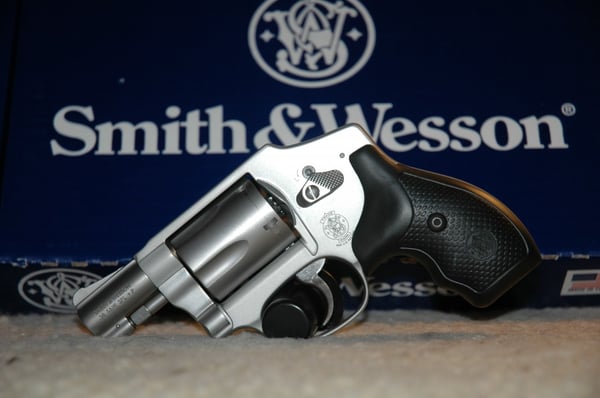
So the question is, are these diminutive hideout guns all the same relevant?
Did you know that:
There are iii major Airweight variants.
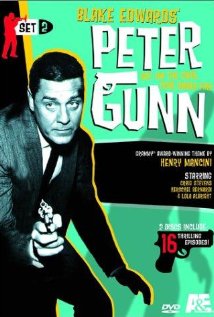
Should everyone follow suit and pack Gunn's gun?
There are ii "cures" for what ails the trigger.
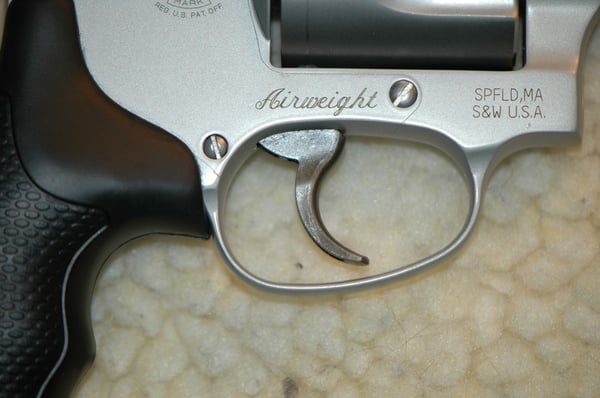
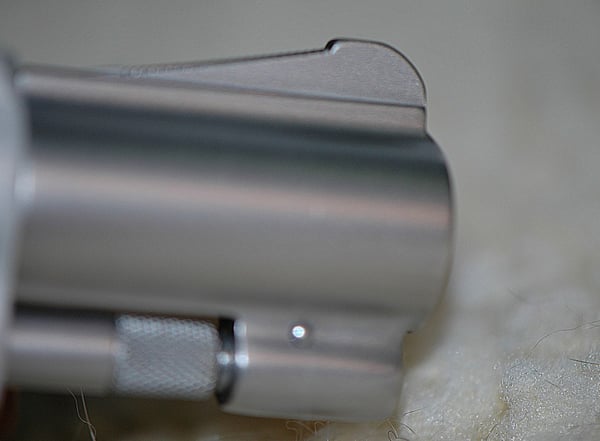
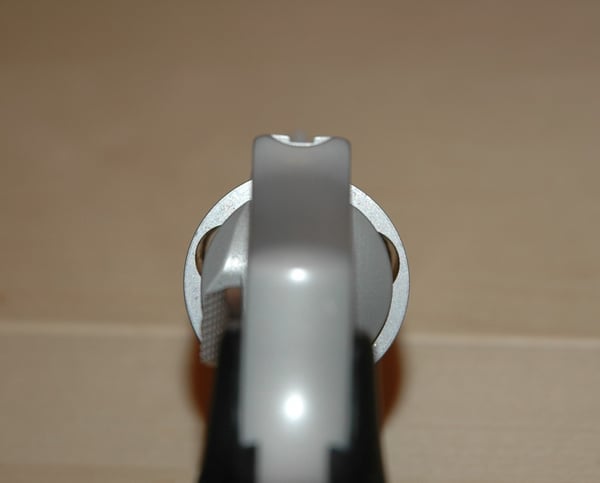
Every bit to the recoil, .38 Specials don't typically kick hard, even in +P.
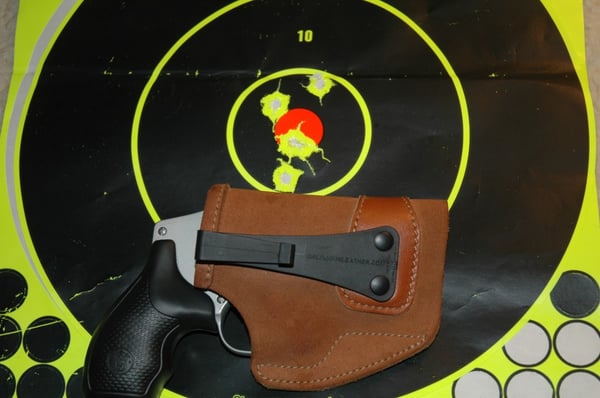
This particular 642 came with the controversial internal lock that most serious shooters despise.
The main argument against any snubby is its five-round capacity.
Another give-and-take of warning to those who may exist considering the purchase of a J-frame for a new shooter: don't.
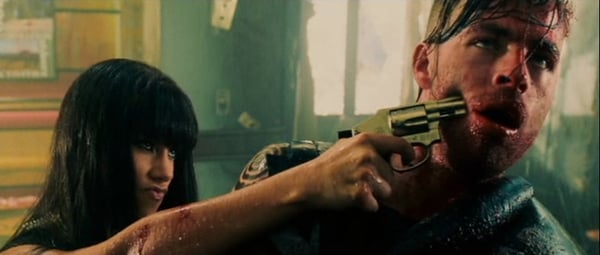
SPECIFICATIONS
Quotient: .38 Special +P
Cylinder chapters: 5 rounds
Materials: Aluminum frame, stainless steel cylinder, crane and barrel
Weight empty: 15 ounces
Butt Length: 1.875″
Overall length: half dozen.31″
Sights: Integral front end, fixed rear
Activeness: Double action only
Cease: Matte argent
Price: $449 MSRP RATINGS (out of five stars)
A style icon for threescore years, carried past every hard-boiled Boob tube cop and few crooks, too. Revolver purists may remember that the Chief's Special looks better than the Centennial or the ugly-duckling Bodyguard. Maybe, but a hammer spur will hang on fabric or leather, precluding pocket comport.
Fits in your pocket like small change. To protect the trigger (to say nothing of the owner's privates), all pocket pieces should be holstered. Lots of good pocket holsters are available for J-frames, and they all work just fine.
Barely a two-finger grip, but that's all anyone should need. Aftermarket grips are bachelor for an all-finger grip. The recoil may scare newbies merely is easily mastered through practice. The front end sight is okay; the rear sight sucks similar gravity.
There volition be peace in the Middle East before this revolver has a misfire. Look "five for sure" for another sixty years or more.
There'south a vibrant aftermarket for grips, including longer ones that enable a full handhold at the expense of darkening. Cherry-red Trace, LaserMax, LaserLyte, Light amplification by stimulated emission of radiation Schmayzer (I made that upward) and others provide enough laser choices to continue Goldfinger happy. There'south no rails on this revolver, so that's it. OVERALL RATING * * * * ane/2
With a high "power to weight" ratio and a street toll well under $400, snubbies are mortiferous authentic, effective and supremely "carryable" self-defence revolvers. New shooters should avoid them. These are proficient guns that shine in the hands of experienced pistoleros.You CAN DetectMore GUN REVIEWS HERE
Source: https://www.maxonshooters.com/blog/gun-review-smith-wesson-model-642